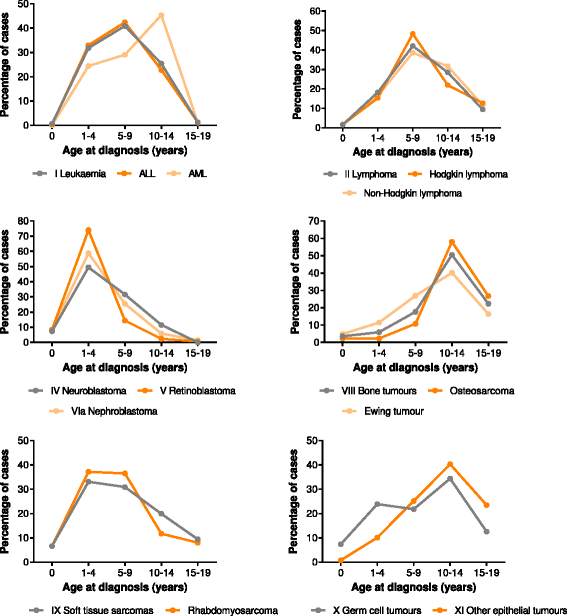Epidemiology of childhood and adolescent cancer in Bangladesh, 2001-2014
- PMID: 26879701
- PMCID: PMC4754803
- DOI: 10.1186/s12885-016-2161-0
Epidemiology of childhood and adolescent cancer in Bangladesh, 2001-2014
Abstract
Background: Cancer burden among children and adolescents is largely unknown in Bangladesh. This study aims to provide a comprehensive overview on childhood and adolescent cancers and to contribute to the future strategies to deal with these diseases in Bangladesh.
Methods: Data on malignant neoplasms in patients aged less than 20 years diagnosed between 2001 and 2014 (N = 3143) in Bangladesh was collected by the National Institute of Cancer Research and Hospital and ASHIC Foundation. The age pattern and distribution of cancer types were analysed and the incidence rates were calculated.
Results: The age-standardised incidence rate was 7.8 per million person-years for children (0-14 years) in the last time period (2011-2014). Retinoblastoma (25%) and leukaemia (18%) were the most common childhood cancers. For adolescents (15-19 years), the age-specific incidence rate was 2.1 per million person-years in the same time period. Most common adolescent cancers were malignant bone tumours (38%), germ cell and gonadal tumours (17%), and epithelial tumours (16%). There were more boys affected (M: F ratio 2.0 in children and 1.4 in adolescents) than girls.
Conclusion: Cancer incidences were lower than expected most likely due to a low level of awareness about cancer among clinicians and the population, inadequate access to health care, lack of diagnostic equipment and incomplete recording of cases. Improvements on different levels should be made to get a better epidemiologic insight and to detect cancer earlier resulting in a better outcome for affected children and adolescents.
Figures
Similar articles
-
Italian cancer figures, report 2012: Cancer in children and adolescents.Epidemiol Prev. 2013 Jan-Feb;37(1 Suppl 1):1-225. Epidemiol Prev. 2013. PMID: 23585445 English, Italian.
-
[Recent incidences and trends of childhood malignant solid tumors in Shanghai, 2002-2010].Zhonghua Er Ke Za Zhi. 2013 Apr;51(4):288-94. Zhonghua Er Ke Za Zhi. 2013. PMID: 23927803 Chinese.
-
Socioeconomic inequalities in cancer incidence and access to health services among children and adolescents in China: a cross-sectional study.Lancet. 2022 Sep 24;400(10357):1020-1032. doi: 10.1016/S0140-6736(22)01541-0. Lancet. 2022. PMID: 36154677
-
Epidemiology of childhood cancer in India.Indian J Cancer. 2009 Oct-Dec;46(4):264-73. doi: 10.4103/0019-509X.55546. Indian J Cancer. 2009. PMID: 19749456 Review.
-
[Epidemiological aspects of childhood cancer].Rev Prat. 2014 Nov;64(9):1264-9. Rev Prat. 2014. PMID: 25638867 Review. French.
Cited by
-
A Systematic Review on Childhood Non-Hodgkin Lymphoma: An Overlooked Phenomenon in the Health and Research Sector of Bangladesh.Cureus. 2023 Sep 25;15(9):e45937. doi: 10.7759/cureus.45937. eCollection 2023 Sep. Cureus. 2023. PMID: 37900448 Free PMC article. Review.
-
Synergistic antitumor effect of suberoylanilide hydroxamic acid and cisplatin in osteosarcoma cells.Oncol Lett. 2018 Oct;16(4):4663-4670. doi: 10.3892/ol.2018.9224. Epub 2018 Jul 27. Oncol Lett. 2018. PMID: 30197679 Free PMC article.
-
Epidemiology of cancers in Lahore, Pakistan, among children, adolescents and adults, 2010-2012: a cross-sectional study part 2.BMJ Open. 2017 Dec 21;7(12):e016559. doi: 10.1136/bmjopen-2017-016559. BMJ Open. 2017. PMID: 29273649 Free PMC article.
-
Impact of Saliva and Cariogenic Microbiota on the Chemotherapy-Induced Oral Mucositis in Oncopediatric Patients: A Preliminary Longitudinal Study.Int J Dent. 2020 Jul 20;2020:1243953. doi: 10.1155/2020/1243953. eCollection 2020. Int J Dent. 2020. PMID: 33163075 Free PMC article.
References
-
- Magrath I, Steliarova-Foucher E, Epelman S, Ribeiro RC, Harif M, Li CK, Kebudi R, Macfarlane SD, Howard SC. Paediatric cancer in low-income and middle-income countries. Lancet Oncol. 2013;14(3):e104–16. - PubMed
-
- World Population Prospects. 2015 Revision: http://esa.un.org/unpd/wpp/Download/Standard/Population/. Accessed 14 Feb 2016.
MeSH terms
LinkOut - more resources
Full Text Sources
Other Literature Sources



